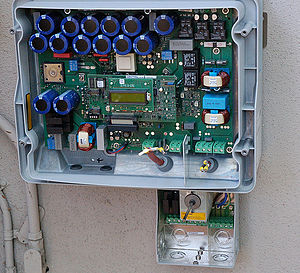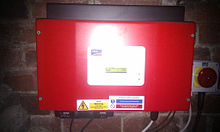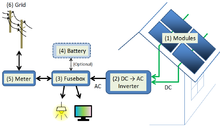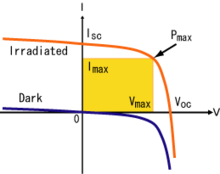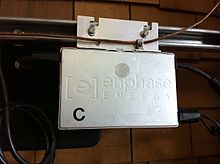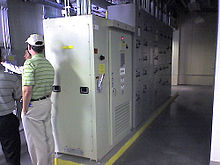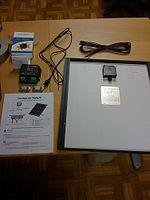- Solar inverter
-
A solar inverter or PV inverter is a critical component in a Photovoltaic system. It performs the conversion of the variable DC output of the Photovoltaic (PV) modules into a utility frequency AC current that can be fed into the commercial electrical grid or used by a local, off-grid electrical network. An inverter allows use of ordinary mains-operated appliances on a direct current system. Solar inverters have special functions adapted for use with PV arrays, including maximum power point tracking and anti-islanding protection.
Contents
Classification
Solar inverters may be classified into three broad types:[citation needed]
- Stand-alone inverters, used in isolated systems where the inverter draws its DC energy from batteries charged by photovoltaic arrays. Many stand-alone inverters also incorporate integral battery chargers to replenish the battery from an AC source, when available. Normally these do not interface in any way with the utility grid, and as such, are not required to have anti-islanding protection.
- Grid tie inverters, which match phase with a utility-supplied sine wave. Grid-tie inverters are designed to shut down automatically upon loss of utility supply, for safety reasons. They do not provide backup power during utility outages.
- Battery backup inverters, are special inverters which are designed to draw energy from a battery, manage the battery charge via an onboard charger, and export excess energy to the utility grid. These inverters are capable of supplying AC energy to selected loads during a utility outage, and are required to have anti-islanding protection.
Maximum power point tracking (MPPT)
Maximum power point tracking is a technique that solar inverters use to get the maximum possible power from the PV array.[2] Solar cells have a complex relationship between solar irradiation, temperature and total resistance that produces a non-linear output efficiency known as the I-V curve. It is the purpose of the MPPT system to sample the output of the cells and apply a resistance (load) to obtain maximum power for any given environmental conditions.[citation needed] Essentially, this defines the current that the inverter should draw from the PV in order to get the maximum possible power (since power equals voltage times current).
The fill factor, more commonly known by its abbreviation FF, is a parameter which, in conjunction with the open circuit voltage and short circuit current of the panel, determines the maximum power from a solar cell. Fill factor is defined as the ratio of the maximum power from the solar cell to the product of Voc and Isc.[3]
There are three main types of MPPT algorithms: perturb-and-observe, incremental conductance and constant voltage.[4] The first two methods are often referred to as hill climbing methods, because they depend on the fact that on the left side of the MPP, the curve is rising (dP/dV > 0) while on the right side of the MPP the curve is falling (dP/dV < 0).[5]
Anti-islanding protection
Normally, grid-tied inverters will shut off if they do not detect the presence of the utility grid.[citation needed] If, however, there are load circuits in the electrical system that happen to resonate at the frequency of the utility grid, the inverter may be fooled into thinking that the grid is still active even after it had been shut down. This is called islanding.[citation needed]
An inverter designed for grid-tie operation will have anti-islanding protection built in; it will inject small pulses that are slightly out of phase with the AC electrical system in order to cancel any stray resonances that may be present when the grid shuts down.[citation needed]
Since 1999, the standard for anti-islanding protection in the United States has been UL 1741, harmonized with IEEE 1547.[6] Any inverter which is listed to the UL 1741 standard may be connected to a utility grid without the need for additional anti-islanding equipment, anywhere in the United States or other countries where UL standards are accepted.[7]
Similar acceptance of the IEEE 1547 in Europe is also taking place, as most electrical utilities will be providing or requiring units with this capability.[8]
Types of anti-islanding protection
There are two types of anti-islanding control techniques:
Passive
The voltage and/or the frequency change during the grid failure is measured and a positive feedback loop is employed to push the voltage and /or the frequency further away from its nominal value. Frequency or voltage may not change if the load matches very well with the inverter output or the load has a very high quality factor (reactive to real power ratio). So there exists some Non Detection Zone (NDZ).
Active
This method employs injecting some error in frequency or voltage. When grid fails, the error accumulates and pushes the voltage and/or frequency beyond the acceptable range.[9]
Solar micro-inverters
Solar micro-inverters convert direct current (DC) from a single solar panel to alternating current (AC). The electric power from several micro-inverters is combined and sent to the consuming devices. The key feature of a micro-inverter is not its small size or power rating, but its one-to-one control over a single panel and its mounting on the panel or near it which allows it to isolate and tune the output of that panel.[citation needed] This also makes expanding the solar power system much easier since additional panels with microinverters can be added to the existing system without as much system change as in upgrading a conventional system with solar inverters.[citation needed]
Microinverters produce grid-matching power directly at the back of the panel. Arrays of panels are connected in parallel to each other and fed to the grid. This has the major advantage that a single failing panel or inverter will not take the entire string offline. Combined with the lower power and heat loads, and improved MTBF, it is suggested that overall array reliability of a microinverter-based system will be significantly greater than a string-inverter based one. Additionally, when faults occur, they are identifiable to a single point, as opposed to an entire string. This not only makes fault isolation easier, but unmasks minor problems that might never become visible otherwise - a single underperforming panel may not affect a short string's output enough to be noticed.
Microinverters have become common where array sizes are small and maximizing performance from every panel is a concern. In these cases the differential in price-per-watt is minimized due to the small number of panels, and has little effect on overall system cost. The improvement in energy collection given a fixed size array can offset this difference in cost. For this reason, microinverters have been most successful in the residential market, where the limited space for panels constraints the array size, and shading from nearby trees or other homes is often an issue. Micro-inverter manufacturers list many installations, some as small as a single panel and the majority under 50.
Another prime reason for the popularity of microinverters is the expandability. A solar array can start with as little as 1 panel & gradually have additional added to it with no maximum size. This is important as a standard string inverter will have to be replaced if the array grows outside of its capabilities.
Grid tied solar inverters
Solar grid-tie inverters are designed to quickly disconnect from the grid if the utility grid goes down. This is an NEC requirement that ensures that in the event of a blackout, the grid tie inverter will shut down to prevent the energy it produces from harming any line workers who are sent to fix the power grid.
Grid-tie inverters that are available on the market today use a number of different technologies. The inverters may use the newer high-frequency transformers, conventional low-frequency transformers, or no transformer. Instead of converting direct current directly to 120 or 240 volts AC, high-frequency transformers employ a computerized multi-step process that involves converting the power to high-frequency AC and then back to DC and then to the final AC output voltage.[10]
The issue at stake currently is that there are concerns about having transformerless electrical systems feed into the public utility grid since the lack of galvanic isolation between the DC and AC circuits could allow the passage of dangerous DC faults to be transmitted to the AC side.[11]
Many solar inverters are designed to be connected to a utility grid, and will not operate when they do not detect the presence of the grid. They contain special circuitry to precisely match the voltage and frequency of the grid.
Solar charge controller
A charge controller may be used to power DC equipment with solar panels. The charge controller provides a regulated DC output and stores excess energy in a battery as well as monitoring the battery voltage to provent under/over charging. More expensive units will also perform maximum power point tracking. An inverter can be connected to the output of a charge controller to drive AC loads.
Solar pumping inverters
Advanced solar pumping inverters convert DC voltage from the solar array into AC voltage to drive submersible pumps directly without the need for batteries or other energy storage devices. By utilizing MPPT (maximum power point tracking), solar pumping inverters regulate output frequency to control speed of the pumps in order to save pump motor from damage.
Inverter failure
Solar inverters may fail due to transients from the grid or the PV panel, component aging and operation beyond the designed limits. Following are some common reasons specific components of inverters age quickly or fail:
Capacitor failure
- Electrolytic materials age faster than polycarbonate and other dry dielectric materials
- Voltage stress
- Continuous operation under maximum voltage conditions
- Frequent short-term voltage transients
- Current stress
- High current increases the internal temperature
- Thermal stress on component terminals
- Improper Charge and discharge rates
- Not operating in ambient temperatures
- Mechanical stress
- Vibrations
Inverter bridge failure
- Usage beyond its rated operating limit
- Overcurrent and overvoltage
- Other malfunctioning components
- Thermal shock
- Thermal overload
- Extremely cold operating temperature
Electro-mechanical wear
- Component stress
- Contamination at contacts
- Extreme temperature conditions
See also
- Grid tie inverter
- Inverter (electrical)
- Solar module
- Solar cell
- Battery charger
- Fill factor
- Power optimizer
References
- ^ Solar Cells and their Applications Second Edition, Lewis Fraas, Larry Partain, Wiley, 2010, ISBN 978-0-470-44633-1 , Section10.2.
- ^ "Invert your thinking: Squeezing more power out of your solar panels". scientificamerican.com. http://www.scientificamerican.com/blog/post.cfm?id=invert-your-thinking-squeezing-more-2009-08-26. Retrieved 2011-06-09.
- ^ "Characteristic Resistance". pveducation.org. http://www.pveducation.org/pvcdrom/solar-cell-operation/charecteristic-resistance. Retrieved 2011-06-09.
- ^ "Evaluation of Micro Controller Based Maximum Power Point Tracking Methods Using dSPACE Platform". itee.uq.edu.au. http://itee.uq.edu.au/~aupec/aupec06/htdocs/content/pdf/165.pdf. Retrieved 2011-06-14.
- ^ Comparative Study of Maximum Power Point Tracking Algorithms. doi:10.1002/pip.459.
- ^ "How Inverters Work". solar.gwu.edu. p. 3. http://solar.gwu.edu/index_files/Resources_files/How-Solar-Inverters-Work-With-Solar-Panels.pdf. Retrieved 2011-06-10.
- ^ "UL 1741 UPDATE A SAFETY STANDARD FOR DISTRIBUTED GENERATION". eere.energy.gov. http://www1.eere.energy.gov/solar/pdfs/14_zgonena.pdf. Retrieved 2011-06-10.
- ^ "Hi‐MW Electronics – One key to a Future Grid which is Smarter, Greener, more Robust and more Reliable". nist.gov. http://www.nist.gov/pml/high_megawatt/upload/Hi-MW3.pdf. Retrieved 2011-06-10.
- ^ "Grid-interactive Solar Inverters and Their Impact on Power System Safety and Quality". eng.wayne.edu. p. 30. http://www.eng.wayne.edu/user_files/374/file/Quick_Upload/Grid_Interactive%20Solar%20Inverters_Anil%20Tuladhar.pdf. Retrieved 2011-06-10.
- ^ Photovoltaics: Design and Installation Manual. Newsociety Publishers. 2004. pp. 80.
- ^ "Summary Report on the DOE High-tech Inverter Workshop". Sponsored by the US Department of Energy, prepared by McNeil Technologies. eere.energy.gov. http://www1.eere.energy.gov/solar/pdfs/inverter_ii_workshop.pdf. Retrieved 2011-06-10.
External links
- List of Eligible Inverters per SB1 Guidelines (Go Solar California)
- Model based control of solar power inverter with battery backup Description and working VisSim source code diagram for digital control of solar power inverter.
Photovoltaics Concepts - Photoelectric effect
- Photovoltaics
- History of photovoltaics
- Timeline of solar cells
- Solar insolation
- Solar constant
- Solar cell efficiency
- Third generation photovoltaic cell
- Solar cell research
- Quantum efficiency of a solar cell
- Cadmium telluride
- Thermophotovoltaic
- Polycrystalline silicon photovoltaics
- Thermodynamic efficiency limit
- Sun-free photovoltaics
- Polarizing organic photovoltaics
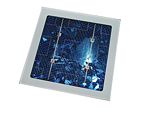
Photovoltaic system Solar cells- Solar cell
- Solar panel
- Thin film solar cell
- Polymer solar cell
- Nanocrystal solar cell
- Organic solar cell
- Quantum dot solar cell
- Hybrid solar cell
- Plasmonic solar cell
- Carbon nanotubes in photovoltaics
- Dye-sensitized solar cell
- Cadmium telluride photovoltaics
- Copper indium gallium selenide solar cells
- Multijunction photovoltaic cell
- Printed solar panel
System components- Solar charge controller
- Solar inverter
- Solar micro-inverter
- Solar cable
- Solar combiner box
- Photovoltaic mounting system
- Maximum power point tracker
- Solar tracker
- Solar shingles
- Solar mirror
System concepts- Perturb and observe method
- Incremental conductance method
- Constant voltage method
- Fill factor
- Concentrated photovoltaics
- Photovoltaic thermal hybrid solar collector
- Space-based solar power
- Watt-peak
Applications Appliances- Solar-powered refrigerator
- Solar air conditioning
- Solar lamp
- Solar charger
- Solar backpack
- Solar tree
- Solar-powered pump
- Solar-powered watch
- Solar Tuki
- Photovoltaic keyboard
- Solar road stud
- Solar cell phone charger
- Solar notebook
- Solar powered calculator
- Solar powered fountain
- Solar powered radio
- Solar powered flashlight
- Solar fan
- Solar street light
- Solar traffic light
Land transport- Solar vehicle
- Solar car
- Solar roadway
- Solar golf cart
- The Quiet Achiever
- Sunmobile
Air transport- Electric aircraft
- Mauro Solar Riser
- Solar panels on spacecraft
- Solar-Powered Aircraft Developments Solar One
- Gossamer Penguin
- Qinetiq Zephyr
- Solar Challenger
Water transportSolar vehicle racing- Solar car racing
- List of solar car teams
- Solar challenge
- Solar Cup
- Blue Sky Solar Racing
- Frisian Solar Challenge
- UC Solar Team
- Solar Splash
- South African Solar Challenge
- Tour de Sol
- World Solar Challenge
- Hunt-Winston School Solar Car Challenge
- North American Solar Challenge
- Victorian Model Solar Vehicle Challenge
Generation systems - Solar Energy Generating Systems
- Stand-alone photovoltaic power system
- Grid-connected photovoltaic power system
- Rooftop photovoltaic power station
- Topaz Solar Farm
- Solar Ark
- Solar Umbrella house
- Erlasee Solar Park
- Guadarranque solar power plant
- Pocking Solar Park
- Copper Mountain Solar Facility
- Wyandot Solar Facility
- Köthen Solar Park
- Building-integrated photovoltaics
- Moura Photovoltaic Power Station
- Nevada Solar One
- Beneixama photovoltaic power plant
- Gottelborn Solar Park
- Darro Solar Park
- Olmedilla Photovoltaic Park
- Blythe Photovoltaic Power Plant
- Strasskirchen Solar Park
- Puertollano Photovoltaic Park
- Alamosa photovoltaic power plant
By countryList of countries by photovoltaics productionPV companies  Category ·
Category ·  CommonsCategories:
CommonsCategories:- Photovoltaics
- Electrical power conversion
Wikimedia Foundation. 2010.

